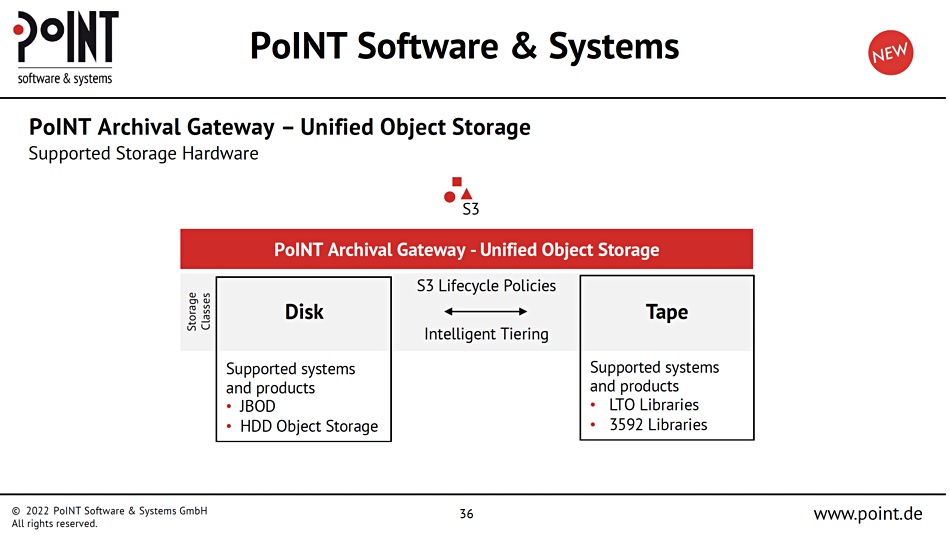Germany’s PoINT Software and Systems has devised a combined disk plus tape archive product with disk random access speed and tape capacity.
Its Point Archival Gateway – Unified Object Storage product is software-defined S3 object storage for disk and tape, presenting their capacity in a single namespace. It is an extension of PoINT’s existing tape-based object storage Archival Gateway.
PoINT told a September IT press tour that putting objects on tape provides support for rich custom metadata which is not available with file systems such as LTFS or proprietary backup formats. Versioning and S3 Object Lock can prevent object alterations and erasure coding provides redundancy.
Its Archival Gateway scales by adding nodes, supports 50 billion objects per S3 bucket, and has up to 230GB/sec throughput across up to 256 tape drives. It supports up to eight tape libraries and is certified by all the main tape library vendors, such as SpectraLogic and Quantum.
The addition of a hard disk drive storage class, with millisecond access times, means applications which expect low latencies, e.g. HPC file systems, and certain backup applications and data management solutions, like iRODS, can use the PoINT Archival Gateway – Unified Object Storage as a target storage system.
Flexible configurations are possible, i.e. tape-only as well as disk-only, with the option of later extension to other storage classes. This provides scope for a possible archive SSD storage tier, using penta-level cell (5bits/cell) flash. Objects are moved between storage classes by AWS S3-compatible lifecycle policies. Expiration policies can be used to define retention periods and implement scheduled deletion of objects.

Policies can be set to automatically move objects on disk after 30 days, for example. This is based on what PoINT calls a cognitive AI that learns which objects are stored where and when it makes sense to move them to tape.
Another policy might delete objects after a set retention time, such as one or two years. Objects that have been moved to tape can be read directly from tape; a restore to disk is not necessary, though it is optionally possible. This is done using the AWS S3 Restore Object command from the Glacier SPI and the restored object’s retention time on disk set by a policy. The software can also perform automatic replication to disk and tape.
Customers have a free choice of storage hardware, such as JBODS or object storage systems from suppliers such as Cloudian and Scality, LTO and IBM 3592 libraries.
This PoINT Systems unified archive competes with SpectraLogic’s archiving products, including its StorCycle file lifecycle management software, Quantum ActiveScale and XenData products.
The benefits of having an on-premises archive system versus a public cloud archive include no ingest, egress and transaction costs, and meeting data sovereignty requirements.








